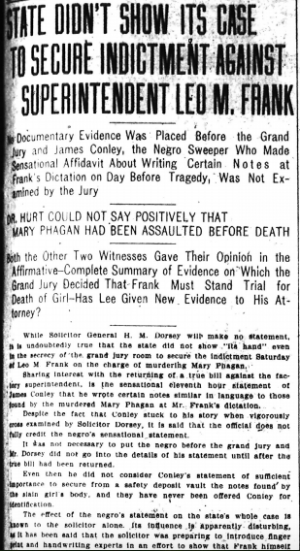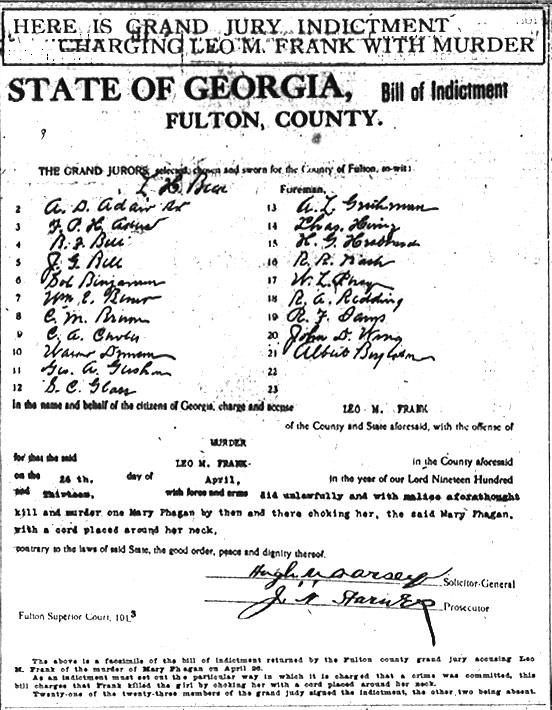 Another in our series of new transcriptions of contemporary articles on the Leo Frank case.
Another in our series of new transcriptions of contemporary articles on the Leo Frank case.
Atlanta Journal
Sunday, May 24th, 1913
No Documentary Evidence Was Placed Before the Grand Jury and James Conley, the Negro Sweeper Who Made Sensational Affidavit About Writing Certain Notes at Frank’s Dictation on Day Before Tragedy, Was Not Examined by the Jury
DR. HURT COULD NOT SAY POSITIVELY THAT MARY PHAGAN HAD BEEN ASSAULTED BEFORE DEATH
Both the Other Two Witnesses Gave Their Opinion in the Affirmative—Complete Summary of Evidence on Which the Grand Jury Decided That Frank Must Stand Trial for Death of Girl—Has Lee Given New Evidence to His Attorney?
While Solicitor General H. M. Dorsey will make no statement, it is undoubtedly true that the state did not show “its hand” even in the secrecy of the grand jury room to secure the indictment Saturday of Leo M. Frank on the charge of murdering Mary Phagan.
Sharing interest with the returning of a true bill against the factory superintendent, is the sensational eleventh hour statement of James Conley that he wrote certain notes similar in language to those found by the murdered Mary Phagan at Mr. Frank’s dictation.
Despite the fact that Conley stuck to his story when vigorously cross examined by Solicitor Dorsey, it is said that the official does not fully credit the negro’s sensational statement.
It was not necessary to put the negro before the grand jury and Mr. Dorsey did not go into the details of his statement until after the true bill had been returned.
Even then he did not consider Conley’s statement of sufficient importance to secure from a safety deposit vault the notes found by the slain girl’s body, and they have never been offered to Conley for identification.
The effect of the negro’s statement on the state’s whole case is known to the solicitor alone. Its influence is apparently disturbing, and it has been said that the solicitor was preparing to introduce finger print and handwriting experts in an effort to show that Frank himself wrote the words on the two sheets of paper found in the basement of the National Pencil factory on the morning of April 27.
If Conley’s story can not be shaken, the experts will not be needed unless it is to swear to the similarity of his handwriting to that of the notes.
It is a significant fact that the renewed interest of the detectives in Conley came after P. A. Fisk, the finger print expert, had examined the notes and the prints of the fingers of the several pencils held in connection with the case.
It has been learned that no documentary evidence, not even the notes themselves, was produced before the grand jury which returned a true bill charging Leo M. Frank with the murder.
Neither Frank’s own statement, nor the statement of Newt Lee in the coroner’s jury was used.
The only “expert” testimony before the grand jury was that of Dr. J. W. Hurt, the county physician. Dr. Hurt, it is said, couldn’t tell the grand jurors whether or not Mary Phagan had been criminally assaulted before she was strangled to death.
This point, it is said, was dealt with by the testimony of Police Sergeant Dobbs, who was among those who first inspected the body, and W. H. Gheesling, of the Bloomfield Undertaking establishment, who prepared Mary Phagan’s body for burial.
In the opinion of both of these men, although neither has especial medical knowledge, the girl was assaulted.
RESUME OF EVIDENCE.
A resume of the evidence, so far as the reporters have been able to learn, which was introduced before the grand jury as follows. Dr. J. W. Hurt told the condition of the slain girl’s body without going into details, it is said, of the result of the exhumations; Police Sergeant Dobbs told of the demeanor of the negro Lee, the position of the body, and other details relative to its finding by the police in the pencil factory basement.
The testimony of Detective J. N. Starnes, who was on the stand Friday, is an unknown quantity. Starnes has been working directly with the solicitor general and has been on the case from the first.

The above is a facsimile of the bill of indictment returned by the Fulton county grand jury accusing Leo M. Frank of the murder of Mary Phagan on April 26. As an indictment must set out the particular way in which it is charged that a crime was committed, this bill charges that Frank killed the girl by choking her with a cord placed around her neck. Twenty-one of the twenty-three members of the grand jury signed the indictment, the other two being absent.
R. P. Barrett, employe of the factory, told of finding the girl’s hair and the supposed blood near it in the machine room of the factory, where, according to the theory of the state, Mary Phagan was first approached by her assailant.
W. W. Rogers, former county policeman, told of the demeanor of Frank when first interviewed by the police after the tragedy, and of circumstances surrounding Frank’s first view of Mary Phagna’s body at the morgue in the undertaking establishment. He told also of Frank’s changing the tape on the time clock Sunday after the tragedy.
Miss Grace Hix, the young lady who worked at a machine next to Mary Phagan at the factory, told of first identifying her friend’s dead body.
E. F. Holloway, day watchman at the factory, told of the position of the elevator on the day of the tragedy and the following morning. So far as Holloway could tell, the elevator had not been moved.
M. B. Darley, general foreman at the factory, testified, but the substance of the statement has never been made professed ignorance of circumstances bearing on it.
Harry Scott, of the Pinkertons, told of the interview which Frank and Newt Lee held in the cell at police headquarters when the negro is alleged to have practically charged his superintendent with the crime, and when Frank is alleged to have told the negro not to discuss the subject any more.
B. B. Haslett, city detective, testified as to the demeanor of Frank when he was placed under arrest on the Tuesday following the tragedy.
FOUND NO ONE IN OFFICE.
Miss Monteen Stover, former employe at the factory, testified that she went to the factory about 12:10 o’clock on the day of the tragedy and just a few minutes after Mary Phagan went there for her pay envelope, and found no one in the office. After waiting some time, Miss Stover says she left the factory and did not return until the Saturday after the tragedy, when she got the pay envelope for which she made the trip to the factory on Memorial day.
J. M. Gantt testified that Frank was [1 word illegible] nervous when he met him at the door of the factory at 6 o’clock on the evening of the tragedy.
W. H. Gheesland, an undertaker, testified that in his opinion Mary Phagan was assaulted before she met her death and he gave it as his opinion that the girl had been dead a number of hours before the body was found.
After a short discussion in which the point that an indictment is by no means a conviction was made, a true bill was returned against Leo M. Frank and the bill against Newt Lee was left untouched. The jurors deliberated only five minutes.
Lee will undoubtedly remain a while in jail.
HAS LEE TALKED?
His lawyer Bernard L. Chappell says he doesn’t want him out and gives the sensational reason that the murderer of Mary Phagan would seek to influence the negro’s testimony in some way. This naturally leads to the inference that Lee has told more than has ever been made public and probably he has told more to his lawyer than to the police despite their vigorous examination.
Solicitor Dorsey states that he did not ask the grand jury to take any action on the negro’s case. Lee has never been held in the light of a principal by the police who have always contended that Frank is responsible for the death of Mary Phagan. Certainly the negro will remain in jail until after the trial of Frank which will probably be set for the third week in June.
The fact that no effort was made to put character witnesses before the grand jury is not considered unusual and in all probability the character witnesses will never testify against the factory superintendent.
The grand jury investigation still leaves as an unknown quantity the results of the analysis of the blood stains on the shirt of Newt Lee, on the shirt of the negro, Conley, and on the floor of the machine room. Of especial interest is this analysis since the rumor that blood, not rust, as the detectives supposed, was found on James Conley’s shirt.
Solicitor Dorsey states that he himself does not know the result of the two post mortems performed by Dr. H. F. Harris, of the state board of health, who twice exhumed Mary Phagan’s body.
Chief of Detectives Newport Lanford characterizes the returning of the indictment against Frank after so few witnesses had been heard as a triumph for the detective department, and declares that the bill was secured without the state having to expose a big part of its case against the accused factory superintendent.
* * *
Atlanta Journal, May 25th 1913, “State Didn’t Show its Case to Secure Indictment Against Superintendent Leo Frank,” Leo Frank case newspaper article series (Original PDF)
